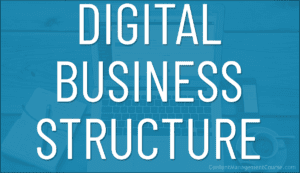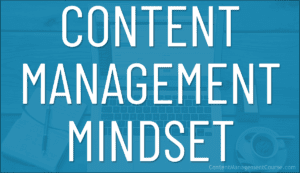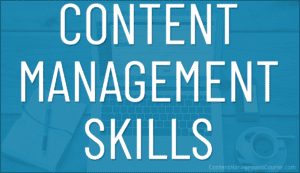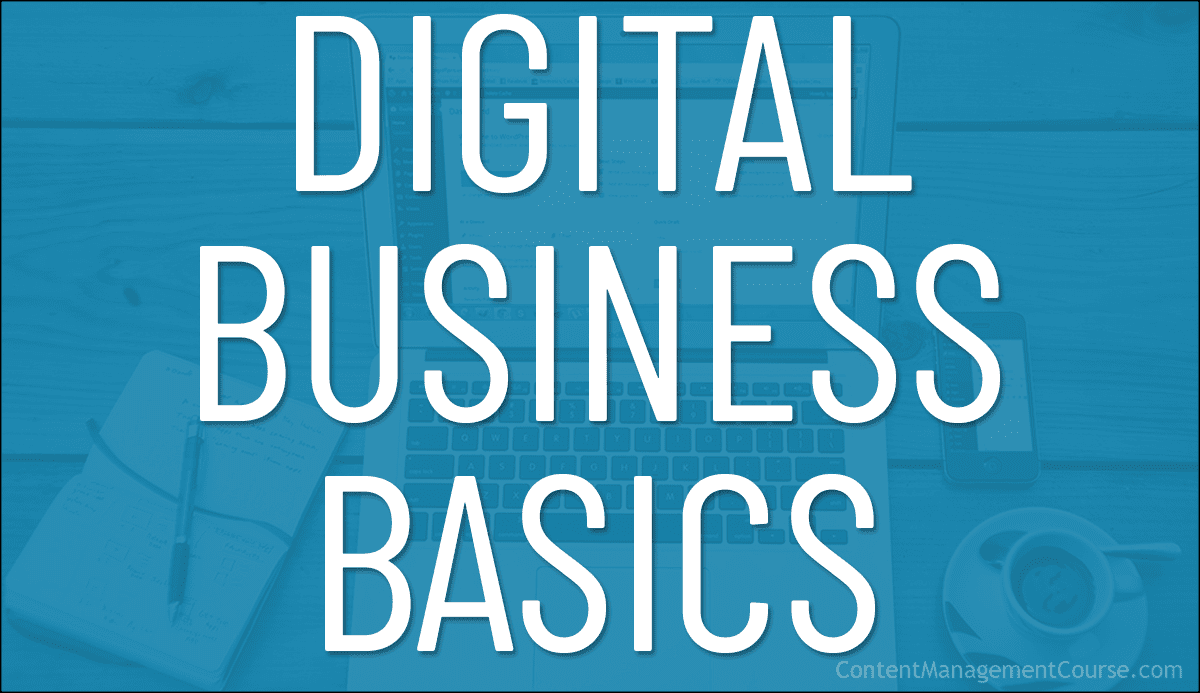Digital Business Basics
This lesson looks at some of the basic steps your business should complete before it can grow using content.
 If your business aims to grow, it needs a clear idea of its values, vision, mission, goals, and objectives.
If your business aims to grow, it needs a clear idea of its values, vision, mission, goals, and objectives.
Preferably, it will also have completed a SWOT analysis at some stage of its business development and have a good understanding of its needs, capabilities, resources, and limitations.
Your business needs this information to perform a business audit and put a budget together to set up and run a digital team, implement systems, and purchase additional software, tools, solutions, services, etc.
This information will also be used to formulate an action plan listing all the practical steps your business will take to grow.
In this lesson, we look at some of the basic steps your business should complete before developing and implementing a Content Strategy.
![]()
Refer to our content management glossary if you need help understanding some of the terms or concepts described in this section.
***
Basic Business Processes
The diagram below shows the processes your business needs to implement before it is ready to grow using various content strategies and methods:

![]()
Providing detailed information on all of the above steps is well beyond the scope of this course, so we’ll briefly review each of these below and we recommend that you refer to the ‘References’ section at the end of this lesson for resources that cover these areas in more depth.
Business Vision
A clear vision built on core values can challenge, inspire, and motivate everyone working in the business to help transform the vision into a success.
For example, if the business has a vision “to be the leading supplier of XYZ products in the QRS industry or the ABC region,” it can then set up a strategy with goals, objectives, and an action plan to achieve this vision.
Having a clearly spelled-out vision that everyone in the business can understand and get enrolled in is very important. Problems will arise if, for example, the business owner and the general manager communicate an entirely different vision of the business to the team. One example of this is if the general manager envisions selling products worldwide but the business owner is only interested in selling nationally. This can create a serious ‘disconnect’ in the business that will affect its strategic decisions.
A clear vision can impact the business planning process in so many ways (e.g., planning for different sites in different languages, currencies, content writing, marketing methods, etc.), so it’s important for the business to have a unified vision and make sure that everyone in the organization is on the same page and working toward it.
Mission Statement
A business mission statement is fundamentally different than a business vision statement.
A business vision statement is a statement that describes the long-term goals and aspirations of a business. It outlines what the company hopes to achieve in the future and serves as a guide for decision-making and strategic planning.
A business mission statement is a statement that describes the purpose and values of a business. It outlines the reason for the company’s existence and what it aims to accomplish in the short term.
In general, a business vision statement is more aspirational and long-term in focus, while a business mission statement is more practical and short-term in focus. A business vision statement is often broader in scope, while a business mission statement is more specific and targeted.
For example, a business vision statement might be: “To be the most admired and respected brand in the world, inspiring people to be their best selves and achieve their dreams.”
A business mission statement might be: “To be the leading provider of healthy, convenient, and delicious food, helping people around the world to live their best lives.”
Also, a vision statement paints a picture of where the business would like to be in the future, whereas a mission statement asks two important and closely related questions about its central focus, activities, and capabilities:
- What business are you in right now?
- What business should you be in right now?
A mission statement sets out what the purpose of the business is and what it aims to achieve, and adds a practical focus to the vision.
Below are some examples of powerful mission statements:
“We believe that buying glasses should be easy and fun. It should leave you happy and good-looking, with money in your pocket,” Warby Parker.
Also…
“Honest Tea seeks to create and promote great-tasting, healthier, organic beverages. We strive to grow our business with the same honesty and integrity we use to craft our products, with sustainability and great taste for all.” Honest Tea.
And…
” Our vision is to create a better everyday life for many people. Our business idea supports this vision by offering a wide range of well-designed functional home furnishing products at prices so low that as many people as possible will be able to afford them.” Ikea.
Core Values
Businesses are driven by their core values. Understanding these values will tell you what the business stands for and what its priorities are.
Businesses can be driven by more than one core value. Here are just some of the core values that can drive a business:
| Accountability | Fame | Peacefulness |
| Achievement | Family | Perseverance |
| Advancement | Financial Security | Power |
| Adventure | Forgiveness | Prosperity |
| Aesthetics | Freedom | Rationality |
| Affection | Growth | Recognition |
| Ambition | Health | Relationships |
| Appearance | Honesty | Reputation |
| Authority | Honor | Respect For Others |
| Belonging | Independence | Responsibility |
| Challenge | Influence | Self-Control |
| Commitment | Inner Peace | Self-Empowerment |
| Communication | Integrity | Self-Respect |
| Competence | Intellectual Status | Service To Others |
| Conformity | Job Satisfaction | Spiritual |
| Control | Knowledge | Stability |
| Cooperation | Leadership | Status |
| Courage | Lifestyle | Success |
| Creativity | Loyalty | Teamwork |
| Decisiveness | Market Share | Tolerance |
| Diplomacy | Meaningful Work | Tradition |
| Efficiency | Merit | Trust |
| Environmental | Money | Truth |
| Ethical Conduct | Morality | Wealth |
| Excellence | Neatness | Wisdom |
| Expertise | Openness | Work Quality |
| Fairness | Order | Work/Life Balance |
Goals & Objectives
Goals are what your business wants to achieve, and objectives are the steps it will need to take to achieve these goals.
Goals and objectives need to be specific, measurable, attainable (i.e. realistic), concrete, challenging, and have a set time frame, yet be flexible enough to be reworked as your business evolves or if circumstances change.
Just as the mission statement moves your business one step closer to the realization of its vision, goals are the practical ‘next step’ that take the mission statement one step further.
Setting practical goals and objectives helps your business set performance targets that can be measured and improved upon and used to formulate action plans for your organization.
So, for example, if your business wants to be able to grow by, let’s say, 20% every year, it will first want to assess how much of this growth is expected to come from digital activities vs offline (e.g., retail) and then set strategic objectives using these targets.
Business Strategy & Business Plan
You can find many great business planning guides online.
Below are some of the main things to consider when developing your business strategy and business plan:
SWOT Analysis
Any business that aims to grow is going to face challenges. Assessing Strengths, Weaknesses, Opportunities, and Threats helps the business identify issues and challenges that can prevent it from achieving its goals and develop a plan to help overcome these.
A SWOT analysis can be used to:
- Assess and prioritize which opportunities are worth pursuing
- Determine which strategies and methods should be implemented to promote different products or services
- Gain a better understanding of core competencies and skills within the business
- Identify competitive advantages, etc.
Business Audit
The Business Audit consists of a series of questions asked of the business to better understand where the business is currently at and whether it has the capabilities and resources to achieve its goals and objectives.
Information gathered during the Business Audit should be referenced in the Action Plan, which should be periodically reviewed and updated as the business evolves.
The Business Audit is divided into different sections, as shown in the example below:
1) Business Details
This information is used to set up new service accounts, add to forms, and used in the content, marketing materials, etc.:
- Registered Company/Business Name
- Company Identifiers (e.g. Company ID, Tax ID, etc.)
- Contact Name(s) of Business Principals/Owners
- Business Address(es)
- Contact Number(s)
- Contact Email(s)
- Website URL(s)
- Other Websites, Social Media accounts
- Hours Of Operation
- Additional Stores/Locations
- Map Co-Ordinates
- Licenses & Qualifications
- Services and subscriptions
- Additional Business Information
Most of this information can be gathered from existing documentation and confirmed with the business owner(s), directors, stakeholders, or managers.
2) About The Business & Its People
This information is used to gain a better understanding of the business and its people, its products, services, and target audience, what problems the business solves for its clients or customers, etc.
Some of this information can be gathered from existing business documentation or by asking the business owner(s), directors, stakeholders, or managers:
- Business description.
- History of the business; when it started, who started it, and why.
- Core values, vision, mission, and purpose.
- How many people are employed, their names, and roles.
- Technical and digital skill levels of team members (e.g. who has image or video editing skills, research or content writing skills, subject knowledge and expertise, knowledge of digital management or marketing processes, software applications, etc.).
- Description of main products and services.
- Description of the ideal customer and target audience, demographics, needs, etc.
- What problems the business solves for clients or customers.
- What makes the business unique, what gives it a competitive edge, why customers should use or buy from the business, etc.
- What is the best benefit or guarantee the business has to offer? Are they aware of any competitors who can match or better this?
3) Strategic Planning
This information is used to plan and develop an effective digital strategy:
Operations
- Is the business comfortably meeting existing demand and supply from customers, or struggling to supply products and services, meet operational targets, etc.? Are customers getting all their orders on time?
- Can the business sustain additional growth from online channels? What percentage of growth?
- How are operational processes being managed? Are there any operational issues that can prevent or slow down sales growth?
- Who has product knowledge and can assist the digital department in areas like content creation, addressing questions and concerns from users on social media, etc.?
Sales
- What’s the main reason or purpose for having a digital presence? Is it to create more exposure and drive more traffic, boost the brand, drive more leads, generate more sales of products or services, educate, inform, or train prospective customers or clients, do all these things, or something else?
- What additional revenue, benefits or improvements does the business expect from its online presence?
- Are there current and historical sales figures for the online channel? What are the projected growth, sales, and revenue targets?
- How will the business manage and measure the results of its digital activities? Will retail activities be tracked and assessed together with or separately from digital activities? Are there any systems in place to do this?
- Does the business plan to expand into new markets or develop new products and services?
4) Marketing Campaigns
This information is used to research and better understand the market and implement an effective digital marketing strategy aimed at delivering better results:
Planning
- What challenges does your business experience in acquiring and retaining customers?
- Does your business plan to target users locally, regionally, nationally, or globally?
- What does your business want to achieve in the short-term, medium-term, and long-term? What are its immediate priorities? Is it to improve lead generation, increase search visibility, drive more traffic, get more sales, improve sales conversions, grow a subscriber mailing list, strengthen brand credibility, reputation management, etc.?
Systems
- How does your business perform market research?
- How does your business perform competitive research?
- How does your business plan, coordinate, and implement new marketing campaigns?
- How quickly can your business coordinate and launch a new marketing campaign?
- Are marketing campaigns being launched across multiple channels simultaneously?
- How does your business track results and improve its marketing campaigns?
Methods
What is your business currently doing to drive more traffic and acquire new customers?
For example (note all that apply):
- Online advertising (e.g. Google AdWords/Facebook Ads/Pay-per-click/Banner ads),
- Web content (e.g. lead gen articles, blog posts)
- Social media (Facebook, Twitter, LinkedIn, YouTube, Pinterest, Instagram, TikTok, other),
- Press/ news/ media releases,
- SEO
- Directory listings
- Video marketing, forums, affiliate marketing, SMS marketing, etc.
- Other/None of the above
What offline methods does your business employ?
For example (note all that apply):
- Media advertising (print, magazine, newspaper ads, radio, tv)
- Directories
- Buying Leads
- Mail Drops (leaflets, magnets)
- Local Media (e.g. coupon mags, calendars)
- Referrals/Networking/Cold Calling
- Other/None of the above
Marketing Calendar
- What are the main trade or industry events or important seasons or dates in the annual calendar? Are marketing campaigns or promotions being run on these dates?
- What campaigns are being run? Who runs these campaigns, and how are they being run?
- Are campaign results being tracked? What kind of results are being generated?
Website & Content
- Does your business currently have a website?
- What technology or platform is driving the website?
- Who looks after and maintains the website?
- Who manages web hosting, domain names, emails, hardware & software security, and looks after all other digital assets?
- Who manages all the online accounts logins and passwords, online services, subscriptions, licenses, etc.?
- Who creates web content, product images, logos, banners, etc.?
- Who manages web templates, files, images, logos, etc.? How/where are these stored? Who backs up files and data? How often are these backed up?
- Does the website meet all legal compliance requirements? Terms of Use, Privacy Statement, Disclaimers, etc.?
- Do all images, brands, logos, trademarks, etc. comply with legal requirements, copyrights, terms of use, licensing, etc.?
- Is the website mobile responsive? How are users being tracked (e.g. Google Analytics)?
- What keywords and locations (cities/towns/suburbs) would your business like to rank #1 for in Google?
- What social media accounts has your business set up? How active are these accounts? What kind of results is your business experiencing with social media?
Targets & Budgets
- What are the acquisition targets (e.g. ideal number of new leads or customers per week/month)?
- What capacity does your business have to handle/service new customers or clients?
- Where is your business now (numbers or %)? Where does it want to get to?
- How happy are customers with your products? What is the percentage of returns or refunds?
- How much are new customers/clients worth (CLV – Customer Lifetime Value) in $$$?
- What is the current marketing spend per month (list all different methods and $$$ being spent on each method)?
- What is the cost of acquisition (number of clicks to convert x cost per click) in $$$?
- What is the total monthly or annual marketing budget?
Additionally …
- How much can your business allocate to building and managing its digital presence?
- What is the annual and/or monthly marketing budget allocated to the digital department and its digital strategy?
- What benchmarks, targets, results, ROIs, or KPIs need to be reached to increase the budget amount to implement additional methods?
Digital Management & Marketing Budget
Your business needs to develop a plan for managing its digital-related expenses and a budget listing the cost of implementing, managing, and performing technical and digital services. This includes:
- Outsourcing digital management tasks (e.g. web hosting, technical support)
- Outsourcing digital content creation tasks (e.g. article writing, images, videos, etc.)
- Outsourcing digital marketing tasks (e.g. press releases, online ads, lead generation, e-commerce fees and transactions, etc.)
- Cost of purchasing essential software, tools, add-ons, licenses, services, and subscriptions,
- Purchasing online training courses, how-to guides, attending training and industry events, etc.
Analyze Competitor Content
Analyzing your competition’s content can provide useful insights for your own strategic business planning.
Use the checklist below to analyze your competitors’ content:
- Define the goals and objectives of your competitor analysis: Clearly define the goals and objectives of the competitor analysis, such as understanding the topics, formats, and strategies that are resonating with your target audience.
- Identify key competitors: Identify the key competitors in your industry that you will analyze.
- Gather competitor information: Gather information on your competitors, such as their website, social media profiles, and any other content they produce.
- Analyze competitor content: Analyze the content of your competitors to understand the topics, formats, and strategies they use to reach their audience.
- Identify competitor strengths and weaknesses: Identify the strengths and weaknesses of your competitors’ content, including what they are doing well and where they could improve.
- Analyze competitor engagement: Analyze the engagement levels of your competitors’ content, including likes, shares, and comments.
- Analyze competitor audience: Analyze the demographics, interests, and pain points of your competitors’ audience to understand their target market.
- Identify opportunities: Identify opportunities for your own content based on the gaps in your competitors’ content and strategies.
- Use the insights: Use the insights from the competitor analysis to inform your own content, product, and marketing strategies.
- Continuously monitor and update: Continuously monitor and update the competitor analysis to keep it relevant and actionable.
Marketing Strategy & Marketing Plan
Wikipedia defines a Marketing Strategy as follows:
“Marketing strategy involves mapping out the company’s direction for the forthcoming planning period, whether that be three, five, or ten years. It involves undertaking a 360° review of the firm and its operating environment with a view to identifying new business opportunities that the firm could potentially leverage for competitive advantage.”
Source: Wikipedia
Investopedia gives this definition:
“A marketing strategy is the business’s overall game plan for reaching prospective consumers and turning them into customers of their products or services. A marketing strategy contains the company’s value proposition, key brand messaging, data on target customer demographics, and other high-level elements.”
Source: Investopedia
A marketing strategy is a high-level approach for reaching a target market and achieving specific business goals. It defines the overall direction and goals for a company’s marketing efforts.
A marketing plan, on the other hand, is a detailed document outlining specific actions to be taken to implement a marketing strategy. It includes details such as budget, target audience, tactics, and metrics for measuring success.
While your marketing strategy is a broader, overarching plan that outlines the reasons why your marketing team will need certain resources, set certain goals, and take certain actions to achieve your business objectives, your marketing plan details the specific actions your team will need to implement to achieve this strategy.
For an excellent practical guide on creating a marketing strategy for your business, including a downloadable marketing plan, go here: How To Create A Complete Marketing Strategy
Marketing Funnel vs Customer Buyer Journey
The marketing funnel and the customer buyer journey are similar concepts but they are not the same.
The marketing funnel is a framework used to describe the journey a potential customer goes through before making a purchase. It typically includes the stages of awareness, interest, consideration, and conversion. The goal of the marketing funnel is to move potential customers through each stage, with the ultimate goal of converting them into paying customers.
The customer buyer journey, on the other hand, is the process a customer goes through to become aware of, evaluate, and purchase a product or service. The stages of the customer buyer journey can include awareness, research, evaluation, and purchase. The goal of the customer buyer journey is to understand the customer’s needs and preferences, and to guide them through the process of making a purchase.
The main difference is that the marketing funnel is often used by marketers to guide their strategy and measure the effectiveness of their campaigns, while the customer buyer journey is more focused on the customer’s experience and understanding their behavior. Both concepts can be used together to create a comprehensive understanding of the customer’s journey.
Develop Your Brand Voice
A brand voice refers to the personality, tone, and language that your business uses to communicate with its audience.
It is the unique way in which your brand expresses itself and is a key component of brand identity. Your brand voice should be consistent across all channels, platforms, and content, and it should align with the overall mission and values of your business.
There are several characteristics that can make up a brand voice, including:
- Tone: The overall tone of your brand’s voice can be serious, funny, formal, or informal.
- Personality: Your brand’s personality can be described as friendly, professional, sophisticated, or approachable.
- Language: The language used in your brand’s voice can be casual, formal, technical, or colloquial.
Examples:
- Nike: The brand voice of Nike is bold, confident, and inspirational. Their messaging often focuses on the idea of pushing limits and achieving personal greatness.
- Apple: The brand voice of Apple is sleek, minimalist, and sophisticated. Their messaging often focuses on the idea of simplicity and ease of use.
- Old Spice: The brand voice of Old Spice is irreverent, playful, and bold. Their messaging often focuses on humor, satire, and satire.
It’s important to note that your brand voice is not only about the words used in your message, but also the visuals and overall design. For example, Apple’s minimalist design aligns with its brand voice of simplicity.
A well-defined brand voice can help your business to stand out in a crowded marketplace, and it can also help to build trust and loyalty with your target audience.
It is an essential tool to create an emotional connection with your audience, and it should be consistently communicated across all your marketing efforts.
How To Create A Brand Voice And Messaging Guide
Creating a brand voice and messaging guide will help your business maintain consistency in your content and messaging across all channels and platforms and make it easy for the team members to understand how to communicate your brand effectively.
Here are the steps for creating a brand voice and messaging guide:
- Define your brand’s personality: The first step in creating a brand voice and messaging guide is to define your brand’s personality. This includes identifying your brand’s unique characteristics, such as its tone, values, and overall personality.
- Define your target audience: Understanding your target audience is key to creating a brand voice that resonates with them. Research your audience’s demographics, pain points, and interests. This will help to create a voice that speaks to them and addresses their needs.
- Develop a brand story: Develop a brand story that aligns with your brand’s personality and speaks to the target audience. The story should be simple, consistent, and memorable.
- Create a brand voice and messaging matrix: Create a matrix that outlines your brand’s different voices and messaging across different channels and platforms. This matrix should include your brand’s core values, tone, and messaging for each channel.
- Develop a style guide: A style guide should be developed that outlines the specific language and tone that should be used in all content. The guide should also include guidelines for grammar, punctuation, and capitalization.
- Communicate the guide: Communicate the brand voice and messaging guide to all stakeholders, including employees, partners, and any external vendors. Provide training to ensure that everyone understands and adheres to the guide.
- Continuously monitor and update: Continuous monitoring and updating of the brand voice and messaging guide is important as your business and the market evolves. Regularly review and update the guide to ensure that it aligns with the business’s current goals, target audience, and market trends.
Digital Business – FAQs
Here are frequently asked questions about digital business:
What is digital business?
Digital business refers to any business that utilizes digital technologies to conduct its operations, interact with customers, and deliver products or services.
What are the key components of a digital business?
Key components include a digital presence (website, social media), e-commerce capabilities, digital marketing strategies, data analytics, and efficient digital communication channels.
Why is digital transformation important for businesses?
Digital transformation enhances operational efficiency, improves customer experience, enables data-driven decision-making, and fosters innovation.
What are the benefits of adopting digital business practices?
Benefits include expanded market reach, increased competitiveness, cost savings, improved customer engagement, and access to valuable data insights.
How do I get started with digital business?
Begin by defining your digital goals, understanding your target audience, investing in a robust online presence, implementing e-commerce solutions, and leveraging digital marketing strategies.
What are some common challenges in digital business?
Challenges include cybersecurity risks, technology integration issues, digital skill gaps, data privacy concerns, and adapting to rapidly evolving digital trends.
How can digital business enhance customer experience?
Digital business can enhance customer experience through personalized interactions, seamless omnichannel experiences, quick response times, and convenient online transactions.
What role does data analytics play in digital business?
Data analytics enables businesses to gain insights into customer behavior, preferences, market trends, and operational efficiency, facilitating informed decision-making and targeted marketing strategies.
How can businesses ensure digital security?
Businesses can ensure digital security by implementing robust cybersecurity measures, conducting regular security audits, educating employees about cyber threats, and complying with relevant data protection regulations.
What are some examples of successful digital business models?
Examples include subscription-based services (e.g., Netflix), platform-based businesses (e.g., Airbnb), digital marketplaces (e.g., Amazon), and software-as-a-service (SaaS) solutions (e.g., Salesforce).
Summary
Having the information above will help the business set realistic goals and objectives and formulate an effective content strategy that can help it realize its vision.
This information must be documented, periodically reviewed, and regularly updated.
Action Steps
Make sure to review and complete the checklists in this section before proceeding to the other training modules.
Resources
- Swot Analysis Template – Download a free SWOT analysis template.
- How To Create A Complete Marketing Strategy – A practical guide for creating a business marketing strategy with a downloadable marketing plan.
- Content Management Glossary – Useful terms and definitions related to the creation, management, and distribution of digital content.
- The Small Business Digital Manager – This guide covers the challenges many small businesses face running an effective digital presence and provides practical ways to address these.
Visit our tools and resources section for additional courses, guides, and helpful tools and resources for content managers.
References
- How To Create A Business Plan
- How To Create A Business Plan Step-By-Step
- How To Write A Business Plan
- How To Conduct A Swot Analysis
- Marketing Strategy (Wikipedia)
- Marketing Strategy: What It Is, How It Works, How To Create One
- How To Create A Complete Marketing Strategy
Digital Business – Module Lessons
Below are all the lessons included in this module. Click on a link to go directly to the lesson:

The Role Of The Content Manager

Digital Business Structure

Content Management Mindset

Content Management Skills

Digital Business Setups

Digital Business Basics

Digital Content Team

Content-Related Jobs and Careers

Content Management Tools
***
Images: Business Plan
